İnfection with various parasites is common in cats, and these parasites are classified into two types: internal parasites and external parasites, internal parasites reside inside the cat's body while external parasites live on the body from the outside in the fur and in the ears, and here the cat breeder must work to prevent and treat their cats from These are dangerous pathological lesions.
 |
Common parasites in cats Diagram |
Mites
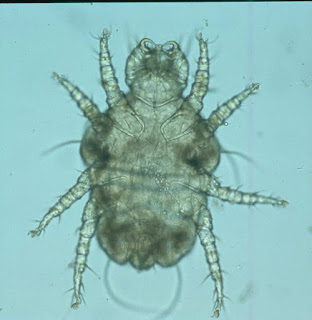 |
A photo of the Cheyletiella moth Cheyletiella mites often resemble dandruff |
Mite parasites are among the types of small spiders, they are examined and viewed using a microscope and these parasites infect various parts of the cat’s skin. They are prevented by using special medicines every month to prevent infection with them in cats. Mites have many types and the following are the types that infect cats:
Face mites or Demodex eyelash mites
This worm mite or demodectic scabies lives on the fur of cats and causes it to have demodectic mites, and it has two types that affect cats: Demodex cati and Demodex gatoi, this type is naturally present on cats, but with decreased immunity, the cat becomes active and proliferates and causes various symptoms, including itching and hair spaces As a result of its fall, inflammation of the skin and the formation of crusts, it is diagnosed by taking a scrape from the throat and examining it microscopically, and various drugs are used to eliminate it, such as topical medications on the skin or injection, as well as drugs to treat the symptoms associated with the infection.
Cheyletiella walking dandruff mite
Dandruff-like mites Cheyletiella or the so-called Filariasis, due to the thread-like symptoms it causes in the skin, this type can be seen with difficulty in the naked eye because it is very small, and this strain of mites causes many symptoms, including itching and scales, and is treated with topical medications.
Scabies notoedric mange mite
This mite can penetrate into the skin of cats, causing itching and peeling of the skin, but it rarely affects cats and is treated with topical medications.
Ear mites
One of the common types in cats is Otodectes cynotis, and like other types of mites, it also causes itching and is very contagious among cats. Topical medications are used to treat it.
Fleas
One of the pests familiar to cats, which are parasites difficult to see on cats, and can easily move to the environment surrounding cats, as this parasite feeds on blood and multiplies quickly and therefore it is difficult to get rid of it. Sprays and powders are used along with topical medications to treat fleas, but it can Giving preventative medications easily to prevent it from causing a problem in the first place.
Cat fleas, Ctenocephalides felis, transmit other dangerous diseases and parasites to cats, and cause various pathological symptoms to the affected cat, such as itching and severe hair loss.
Intestinal parasites
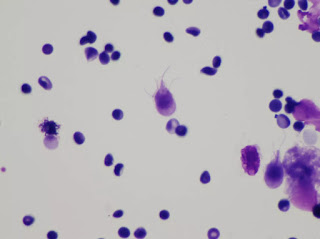 |
Giardia lamblia |
These internal parasites infect the cat's digestive system in the stomach and intestines, and include both worms, eggs, and protozoa unicellular parasites. Only adult worms can be seen with the naked eye, and a routine laboratory examination of the stool is required to diagnose infection, which requires medications. Various types to eliminate them, and we will review their types here:
Giardia
It is a microscopic protozoan parasite that parasites on the intestinal cells of cats, causing a lot of digestive disorders such as diarrhea, and it is transmitted to cats through contaminated soil and water.
Coccidia
It is also microscopic that causes diarrhea in cats as a result of it parasitizing intestinal cells and has many types, including Isospora felis, Isospora rivolta, Sarcocystis, and Toxoplasma gondii (which can also be infected by humans).
Whipworms
They are whip-like parasites that cause diarrhea by parasitizing the intestine. Their life cycle includes eggs and larvae that are in the intestine of infected cats.
Hookworms
It is another intestinal parasite that has both the roundworm and microscopic egg stage in cats, where hookworms cause diarrhea and other digestive symptoms in cats and the most common hookworms in cats are Ancylostoma tubaeforme and Ancylostoma braziliense.
Roundworms
Very common in cats, they are spaghetti-like worms when watered in cat feces. They also have a microscopic egg stage. These worms often cause cats to have a bloated or round stomach along with loose and sometimes vomiting stools.
Tapeworms
It is often transmitted to cats through fleas. These worms resemble pieces of rice in the stool, but there are also microscopic eggs. This worm is known to cause weight loss.
Ticks
These relatively large parasites stick to the cat's skin and feed on its blood, and contribute to transmitting a range of diseases to cats, so they must be prevented and eliminated, and there are several different types of ticks that can infect cats. Some common types of ticks include:
Lone Star Tick
Sometimes found on cats, this type is called Amblyomma americanum, and this tick can spread a deadly parasite in the blood called Cytauxzoon felis.
Wood tick or American dog tick
Despite the name, this tick can also be found on cats and causes Rocky Mountain Spotted Fever.
Deer tick (Blacklegged) Tick
This felid species of ticks is referred to as the deer tick, and cats can become infected with anaplasmosis.
Heartworms
These worms are transmitted to cats through mosquito bites, which are microscopic internal parasites that are difficult to detect in cats due to the difficulty of identifying them in laboratory analyzes, as heartworm tests search for special proteins called antigens that the adult female worms release. The test is positive even if there are immature worms in the cat. But although there are no adult worms to reproduce in the body, immature worms can cause severe damage to a cat's respiratory system and ultimately lead to death. There is no cure for heartworm in cats, but prevention with medication is very effective.
Cuterebra skin piercing flies
The larvae of these flies intrude on the skin by feeding on the blood by puncturing the skin, causing swelling that grows and causes a hole in the skin. The larvae can be seen in this hole before their appearance, but sometimes the larvae must be surgically removed. The swelling and inflammation usually lead to an abscess that requires medication and cleaning to control the infection.
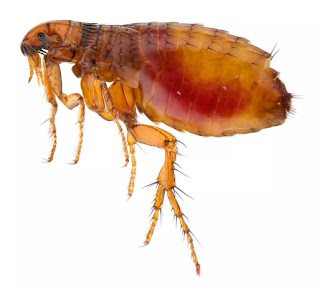
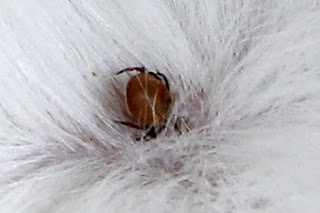
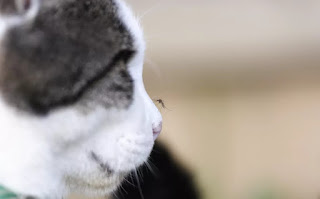

Comments
Post a Comment